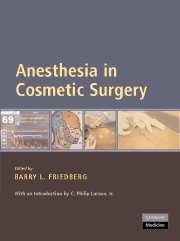Book contents
- Frontmatter
- Contents
- Foreword
- Acknowledgments
- Introduction
- Preface
- List of Contributors
- PART I MINIMALLY INVASIVE ANESTHESIA (MIA)Ⓡ FOR MINIMALLY INVASIVE SURGERY
- 1 Propofol Ketamine with Bispectral Index (BIS) Monitoring
- 2 Preoperative Instructions and Intraoperative Environment
- 3 Level-of-Consciousness Monitoring
- 4 The Dissociative Effect and Preemptive Analgesia
- 5 Special Needs of Cosmetic Dental Patients
- 6 Propofol Ketamine in the UK, Propofol Ketamine Beyond Cosmetic Surgery
- 7 Propofol Ketamine Beyond Cosmetic Surgery: Implications for Military Medicine and Mass-Casualty Anesthesia
- 8 Lidocaine Use and Toxicity in Cosmetic Surgery
- 9 Local Anesthetic Blocks in Head and Neck Surgery
- 10 Local Anesthetics and Surgical Considerations for Body Contouring
- PART II ALTERNATIVE ANESTHESIA APPROACHES IN COSMETIC SURGERY
- PART III OTHER CONSIDERATIONS FOR ANESTHESIA IN COSMETIC SURGERY
- APPENDIX A A Guide to Perioperative Nutrition
- APPENDIX B Reflections on Thirty Years as an Expert Witness
- Index
- References
8 - Lidocaine Use and Toxicity in Cosmetic Surgery
from PART I - MINIMALLY INVASIVE ANESTHESIA (MIA)Ⓡ FOR MINIMALLY INVASIVE SURGERY
Published online by Cambridge University Press: 22 August 2009
- Frontmatter
- Contents
- Foreword
- Acknowledgments
- Introduction
- Preface
- List of Contributors
- PART I MINIMALLY INVASIVE ANESTHESIA (MIA)Ⓡ FOR MINIMALLY INVASIVE SURGERY
- 1 Propofol Ketamine with Bispectral Index (BIS) Monitoring
- 2 Preoperative Instructions and Intraoperative Environment
- 3 Level-of-Consciousness Monitoring
- 4 The Dissociative Effect and Preemptive Analgesia
- 5 Special Needs of Cosmetic Dental Patients
- 6 Propofol Ketamine in the UK, Propofol Ketamine Beyond Cosmetic Surgery
- 7 Propofol Ketamine Beyond Cosmetic Surgery: Implications for Military Medicine and Mass-Casualty Anesthesia
- 8 Lidocaine Use and Toxicity in Cosmetic Surgery
- 9 Local Anesthetic Blocks in Head and Neck Surgery
- 10 Local Anesthetics and Surgical Considerations for Body Contouring
- PART II ALTERNATIVE ANESTHESIA APPROACHES IN COSMETIC SURGERY
- PART III OTHER CONSIDERATIONS FOR ANESTHESIA IN COSMETIC SURGERY
- APPENDIX A A Guide to Perioperative Nutrition
- APPENDIX B Reflections on Thirty Years as an Expert Witness
- Index
- References
Summary
INTRODUCTION AND OVERVIEW
The use and toxicity of lidocaine in modern cosmetic surgical practice is arguably the most important topic for any anesthesiologist or surgeon working in this field of medicine. Lidocaine toxicity, primarily in the context of suction assisted lipectomy (SAL), lipoplasty, or liposuction, has historically accounted for a significant proportion of patient morbidity and mortality.
This chapter covers lidocaine pharmacology, the history of lidocaine use in the context of cosmetic/plastic surgical practice, and the politics or practical concerns of pushing the envelope toward higher, “megadose” tumescent lidocaine solutions. As there are ample resources to address the basic structure of the lidocaine molecule, and multiple books and articles on the basic science and pharmacokinetics of lidocaine, no space is wasted in displaying this information. Similarly, the related subjects of peribulbar versus topical anesthesia in ophthalmic surgery and transient neurotoxic symptoms in lidocaine spinal anesthesia are not analyzed in this context.
BRIEF PHARMACOLOGY
Lidocaine, an amide molecule synthesized from cocaine, was first applied in the practice of medicine in 1948. As clinical applications and the advancement of medicine expanded the role of lidocaine, this drug found a niche applied topically and subcutaneously for local anesthesia for a variety of surgical procedures. Lidocaine is used intravenously to treat ventricular arrhythmias. Dilute solutions of lidocaine mixed with epinephrine are administered as tumescent solution for liposuction cosmetic surgery.
- Type
- Chapter
- Information
- Anesthesia in Cosmetic Surgery , pp. 72 - 83Publisher: Cambridge University PressPrint publication year: 2007



